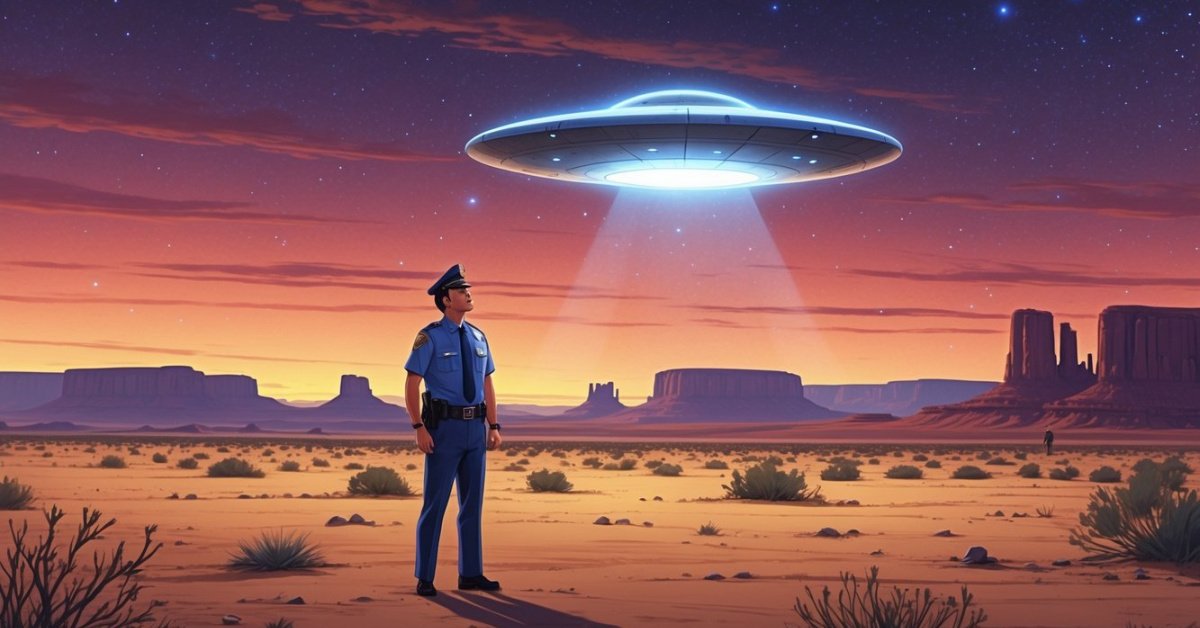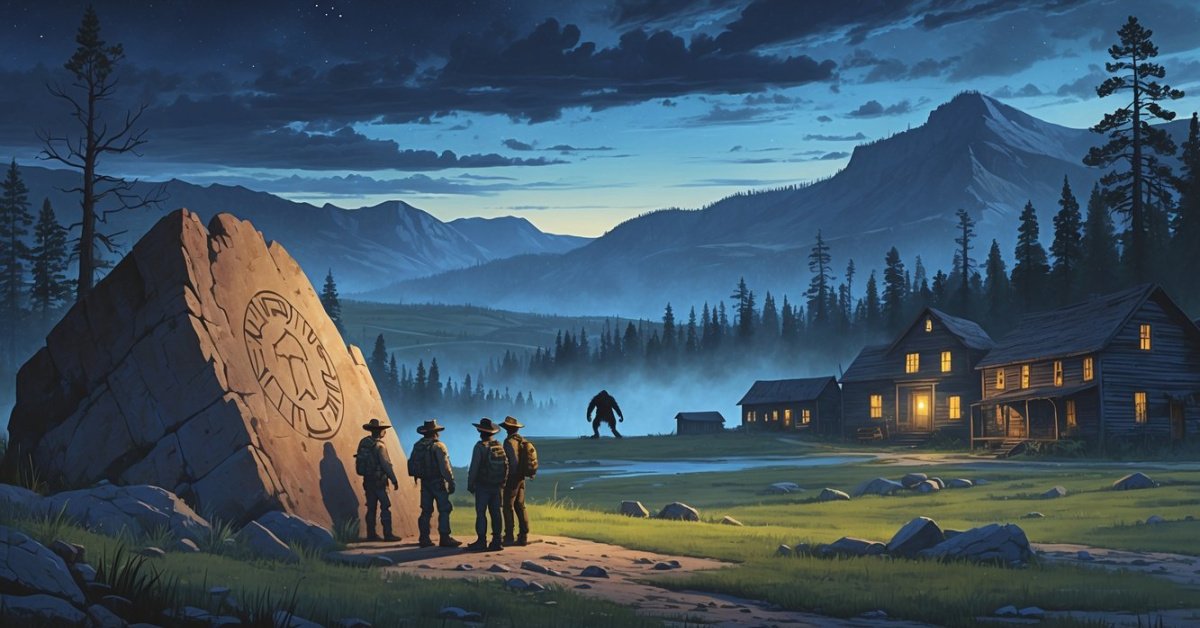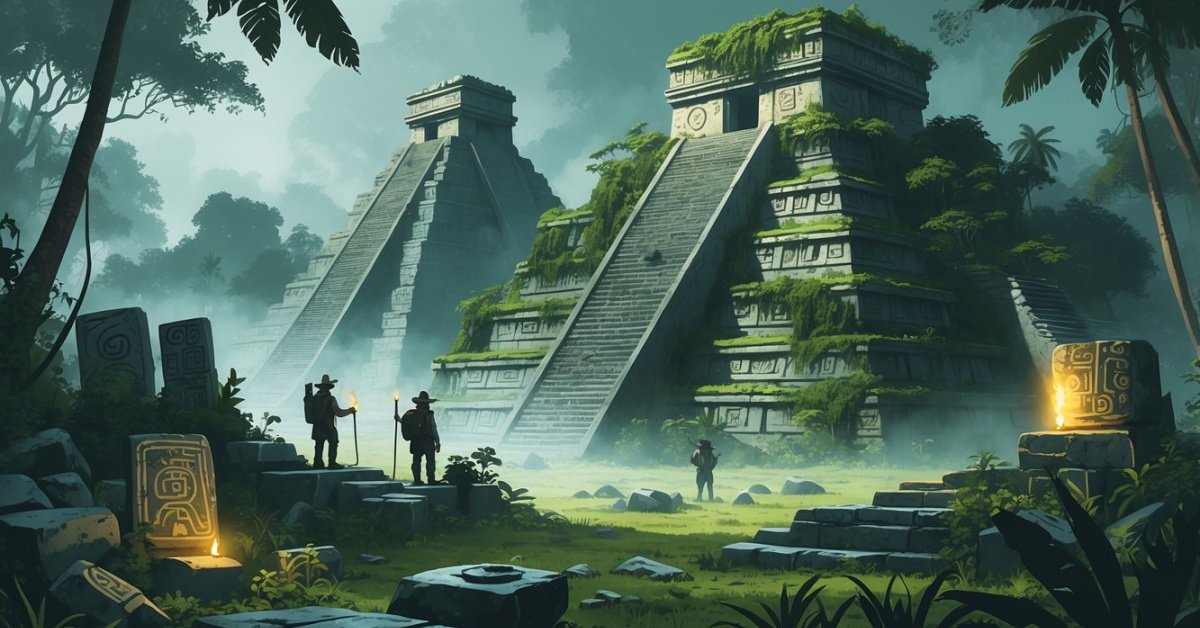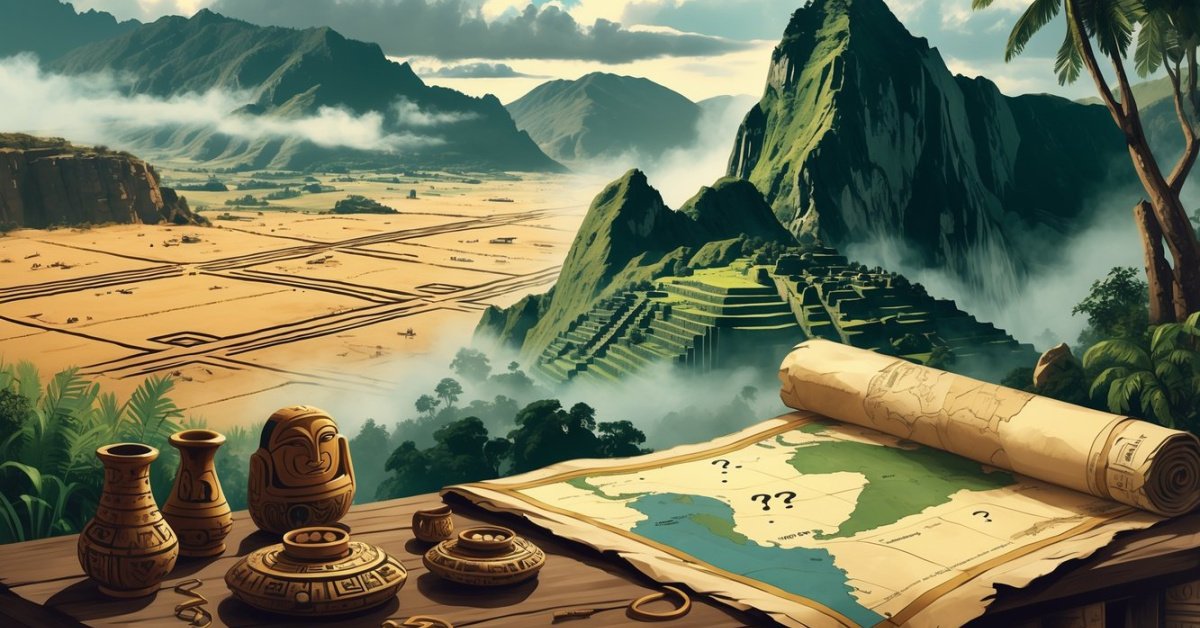On April 24, 1964, Socorro police officer Lonnie Zamora saw something he could not explain in the New Mexico desert. While chasing a speeding car, he noticed a loud roar and a flash of blue and orange flame.
Curious, Zamora drove toward the noise and found an unusual, egg-shaped craft on the ground. The object lifted off in front of him and left behind physical traces that investigators later confirmed as real.

The Lonnie Zamora incident became one of the most studied cases in UFO history. Project Blue Book, local authorities, and scientists examined the landing site.
Witness accounts, physical evidence, and official reports make this case stand out from other UFO stories. The story unfolds step-by-step, from Zamora’s pursuit to the impact on UFO research.
Overview of the Lonnie Zamora Incident
In 1964, a police officer in Socorro, New Mexico, saw a strange craft and two small figures in the desert. The event drew attention because of physical evidence at the scene and the credibility of the witness.
Significance in UFO History
People often call the Lonnie Zamora incident one of the most credible UFO sightings. A trained observer—a uniformed police officer—reported the event.
Investigators found physical traces at the landing site, including burned vegetation and indentations in the ground. These details set the case apart from typical sightings based only on eyewitness accounts.
Project Blue Book, the U.S. Air Force program that investigated UFOs, took interest in the case. Astronomer J. Allen Hynek, who often explained sightings as natural or man-made, called the Socorro event “one of the classics of UFO literature.”
Researchers still use this incident as a reference point for studying UFO sightings in New Mexico.
Location and Date
The sighting happened on April 24, 1964, around 5:45 p.m. in Socorro, New Mexico. The area is surrounded by open land, with few buildings outside the town center.
Zamora was on patrol when he began chasing a speeding car. During the pursuit, he heard a loud roar and saw a bluish-orange flame in the distance.
He drove toward the sound and found an oval or egg-shaped craft on the ground. The craft was white and had a strange red symbol on its side.
The site was just south of town, in a dusty arroyo. Later, investigators found signs of heat damage at the location.
Immediate Public Reaction
News of the sighting spread quickly across Socorro. Residents were curious but cautious about believing the story.
Local reporters interviewed Zamora, who gave consistent details in several accounts. His calm and straightforward manner added weight to his testimony.
Air Force investigators and journalists arrived within days. Newspapers nationwide covered the incident, highlighting the burned brush and landing marks.
Some skeptics suggested experimental aircraft. No official explanation was confirmed, and the lack of answers kept the Socorro UFO case in public discussion for years.
Lonnie Zamora: The Witness
Lonnie Zamora was a well-known figure in Socorro, New Mexico, before his 1964 sighting. His calm nature and steady work ethic made him a trusted member of the community.
People knew him as someone who valued facts and avoided attention.
Background and Reputation
Lonnie Zamora was born in 1933 and spent most of his life in Socorro. He came from a working-class background and had a reputation for honesty and reliability.
Friends and neighbors described him as quiet but approachable. He was not known for telling wild stories.
By 1964, Zamora had built strong connections in the town. Many residents respected him for his straightforward manner and his willingness to help others.
His personal life was stable. He was married, attended church, and took part in local activities.
Because of his consistent character, locals and investigators believed he had no reason to invent or exaggerate his story.
Role as a Police Officer
Zamora joined the Socorro Police Department in the late 1950s. His duties included traffic enforcement and responding to emergencies.
He often patrolled rural areas outside town, which made him familiar with the desert terrain. On April 24, 1964, this routine work led him to the site of the UFO.
As an officer, Zamora was trained to observe details and report them accurately. His police reports were known for being clear and factual.
When he described the strange craft and figures, investigators from Project Blue Book noted that his account matched his usual careful reporting style.
His role as a law enforcement officer made his testimony harder to dismiss.
Chronology of the Socorro UFO Encounter

On April 24, 1964, Socorro police officer Lonnie Zamora reported an unusual airborne vehicle. The event began with a pursuit, included a loud explosion, and ended with a close-range sighting of the craft and its occupants.
Initial Pursuit and Explosion
Lonnie Zamora was on patrol in Socorro, New Mexico, when he began chasing a speeding car south of town. During the pursuit, he heard a sudden loud roar and saw a flash of orange and blue flame in the distance.
The noise was strong enough to make him abandon the traffic stop. He drove toward the sound, thinking it might be an accident or an explosion from a nearby dynamite storage shack.
Dust in the air limited his view at first. As he approached the area, the roaring sound faded.
The scene ahead appeared calm, but he noticed movement on the ground near a small arroyo.
Discovery of the Object
Zamora stopped his patrol car on a dirt road and got out to get a better look. In the arroyo below, he saw a white, egg-shaped object resting on landing legs.
The craft had no visible windows but displayed a red insignia on its side, which he later described to investigators from Project Blue Book. The craft was about the size of a small car.
The surface looked smooth and metallic in the afternoon light. He also noticed the ground around it was disturbed, with dust and debris scattered outward as if displaced by force.
Observation of Occupants
While scanning the area, Zamora saw two small figures standing near the object. They wore white coverall-like suits and seemed to be examining the ground or the craft.
He described them as human-like but could not see their faces. They appeared startled when they noticed him.
Within moments, the figures entered the object. The craft then lifted off with another loud roar and a visible flame.
It rose quickly, cleared a nearby hill, and disappeared into the sky. The craft left behind burn marks and landing impressions that investigators from UFO Evidence later documented.
Description of the UFO and Its Occupants

On April 24, 1964, Lonnie Zamora reported seeing an unusual airborne vehicle on the outskirts of Socorro, New Mexico. His account described a craft with a distinct shape, unique markings, and two small beings nearby before it lifted off with a loud roar and visible flame.
Shape and Appearance
Zamora described the UFO as an oval or egg-shaped craft resting on the ground. It appeared metallic and had a smooth, shiny surface that reflected sunlight.
The craft stood on legs or landing gear, which left impressions in the soil. It was large enough for a person to enter but smaller than most conventional aircraft.
Witnesses estimated its length at about 15–20 feet and its height at about 10–15 feet. There were no visible windows, doors, or wings.
When it took off, Zamora saw a bright blue and orange flame shoot from the underside. He heard a loud roaring sound as the object rose quickly and flew away at an angle.
Red Insignia and Markings
One of the most distinctive details was a red insignia on the side of the craft. Zamora recalled it as an upright oval with a horizontal line through the center and several vertical lines or shapes inside.
He later drew the symbol for investigators, and Project Blue Book included it in their official report. The marking did not match any known U.S. military or commercial aircraft insignia.
Investigators noted that Zamora’s description of the symbol stayed consistent in several interviews.
Reported Beings
Zamora said he saw two small figures near the craft before it took off. They looked human-like but were shorter than average adults, possibly around 4–5 feet tall.
They wore white or light-colored coveralls and seemed to have large heads compared to their bodies. He could not see facial features from his distance.
The beings moved quickly, and one appeared startled when it noticed him. Within moments, they entered or moved behind the craft, which then lifted off and departed.
For more details on his account, see the Lonnie Zamora incident.
Physical Evidence and Trace Analysis

Investigators documented several physical traces at the Socorro site that matched Officer Lonnie Zamora’s account. These included unusual ground impressions, scorched plants, and possible residue linked to the object he reported seeing.
Landing Marks and Impressions
Zamora led investigators to four distinct depressions in the sandy soil. Each was roughly circular and appeared evenly spaced, forming a rectangular pattern.
Measurements suggested the marks could match landing legs from a craft-like object. The soil in these spots was compacted, which indicated pressure from a heavy load.
A simple diagram recorded during the investigation showed the spacing between impressions:
| Mark | Distance to Next Mark | Depth |
|---|---|---|
| 1 | 15 ft | 2 in |
| 2 | 19 ft | 2 in |
| 3 | 15 ft | 2 in |
| 4 | 19 ft | 2 in |
These measurements matched Zamora’s description of an egg-shaped craft resting on four legs before taking off.
Scorched Vegetation
Nearby desert plants showed signs of intense heat exposure. Several bushes had blackened leaves, and some stems were brittle and fractured.
Investigators saw that the burn pattern was concentrated around the landing marks, with the most damage directly beneath and behind where the object had been. Tests suggested the scorching could not be explained by a brush fire or vehicle exhaust from known aircraft of the time.
The burn marks and vegetation damage became one of the strongest physical traces supporting Zamora’s account.
Metal Scrapings
Investigators collected small metallic particles from rocks at the site. These scrapings fused to the surface, as if extreme heat had exposed them.
The samples looked silvery and were hard to remove without chipping the rock. Some investigators thought the residue might have come from the craft’s landing gear or exhaust.
Laboratory analysts at the time could not match the samples to common industrial alloys. The metallic residue added another layer of physical evidence to the Socorro case.
Immediate Response and Investigation

When Lonnie Zamora reported the strange object in Socorro, New Mexico, local and federal agencies reacted quickly. Law enforcement, military personnel, and investigators arrived to secure the site and document evidence.
They interviewed witnesses and worked to preserve the scene.
Local Police Involvement
Zamora, a Socorro police officer, radioed the station for help. Sergeant Sam Chavez, another officer, responded within minutes.
They found fresh impressions in the soil, scorched vegetation, and a lingering smell like burning. Officers marked and photographed the site before anyone disturbed it.
The police spoke to residents who had heard a loud roar or seen dust rising in the distance. They logged these statements in the official report.
Local authorities kept onlookers away from the landing area to protect the markings. Their quick action helped preserve the physical evidence for later analysis.
Arrival of Captain Richard T. Holder
Within hours, Captain Richard T. Holder, the Army’s commander at White Sands Missile Range’s test facility, arrived at the scene. He brought military police to help secure the area.
Holder interviewed Zamora in detail, asking about the object’s shape, size, color, and movements. He reviewed the layout of the landing site and the tracks found there.
Holder and the police created a sketch map of the scene, marking the four depressions in the ground and the burn patterns.
Holder treated the incident seriously and focused on documenting the event. His presence showed the military’s interest in the case.
FBI and Military Presence
The FBI sent agents from its Albuquerque office soon after Holder arrived. Air Force investigators from Kirtland Air Force Base joined them at the scene.
Military and federal personnel took photographs, measured the impressions, and collected soil and plant samples. They sent these samples for laboratory testing.
Investigators contacted White Sands Missile Range to check for experimental aircraft in the area. Records showed no scheduled tests at that time.
Project Blue Book and Official Inquiries

The Lonnie Zamora sighting in Socorro, New Mexico, drew attention from Project Blue Book, the U.S. Air Force’s UFO investigation program. Investigators examined physical traces at the site and interviewed witnesses.
They compared the account with known aircraft and space activity. Scientists and military officials who specialized in aerial phenomena contributed to the inquiry.
Project Blue Book’s Findings
Project Blue Book classified the Socorro case as “unexplained” after months of review. Investigators documented burn marks, landing impressions, and scorched vegetation at the site.
They compared these findings with possible causes, such as experimental aircraft, helicopters, or hoaxes. None matched the physical evidence or Zamora’s account.
Declassified Project Blue Book case files described the object as oval-shaped with unusual markings. The report noted the craft’s rapid, silent departure and lack of debris.
Role of Dr. J. Allen Hynek
Dr. J. Allen Hynek, an astronomer and scientific consultant for Project Blue Book, visited Socorro soon after the event. He interviewed Lonnie Zamora and reviewed the physical evidence firsthand.
Hynek considered Zamora a credible and consistent witness. The officer’s account did not change under repeated questioning, and the site’s physical traces matched the timeline.
Hynek ruled out weather balloons, aircraft misidentification, and astronomical objects. In his later writings, he cited the Socorro case as one of the most puzzling incidents he studied.
Report by Hector Quintanilla
Major Hector Quintanilla, the last director of Project Blue Book, oversaw the Air Force investigation. He reviewed all collected evidence, including photographs, soil samples, and witness interviews.
Quintanilla’s final report acknowledged the thorough search for a conventional explanation but found that no known technology or natural phenomenon fit the facts.
He considered hoax theories but found no evidence that Zamora fabricated the story. Interviews with other residents supported the timeline of the sighting.
Quintanilla called the Socorro incident “one of the most perplexing cases” in the Blue Book files, noting its combination of physical evidence and credible testimony.
Other Witnesses and Corroborating Sightings

Several people besides Lonnie Zamora reported events that matched parts of his account. These included another police officer and multiple civilians.
Some reports came from nearby areas around the same time. They added details about the object’s appearance and movements.
Sergeant Sam Chavez’s Observations
Sergeant Sam Chavez arrived at the landing site shortly after Zamora called for assistance. By the time he got there, the object was gone.
He saw fresh burn marks on the ground and four distinct depressions in the soil. These matched the positions where landing legs might have rested.
Chavez also noted scorched bushes in the arroyo. Official files stated the marks were still warm when he inspected them.
His observations supported Zamora’s claim that something had just taken off from the area.
Civilian Witness Accounts
Several Socorro residents reported seeing a strange object in the sky around the same time as Zamora’s sighting. Some described it as shiny and egg-shaped. Others noticed a blue and orange flame trailing from it.
One driver told investigators they saw the craft flying low and fast before it disappeared behind a hill. Another local reported hearing a loud roar, similar to what Zamora described.
These accounts gave investigators more than one point of reference for the object’s flight path. Multiple people saw something unusual that day.
Similar Sightings in New Mexico
Around the same period, other UFO sightings were reported in different parts of New Mexico. A notable case occurred in La Madera, where witnesses said they saw a similar object and found ground markings afterward.
Reports from La Madera described a metallic craft and unusual heat damage to vegetation. The site showed signs of a possible landing.
These sightings were separate but close in time to the Zamora incident. The similarities in shape, color, and flight behavior suggested that more than one person in the state witnessed the same type of object.
Media Coverage and Public Perception
The Lonnie Zamora incident in 1964 attracted attention from local newspapers, national media, and government investigators. It sparked curiosity, debate, and speculation about what the Socorro police officer saw that day.
National Headlines
Within days, the story appeared in major U.S. newspapers and on television news programs. Reporters highlighted Zamora’s role as a respected police officer, which gave his account credibility.
Project Blue Book, the U.S. Air Force’s UFO investigation program, quickly became involved. Their interest increased media coverage, as official government attention suggested the event was unusual enough to warrant study.
Publications such as the Associated Press and United Press International distributed the story nationwide. This led to radio and TV interviews, and even international outlets picked it up.
The national press often repeated key details: the egg-shaped craft, the two small figures, and the strange landing marks. These consistent descriptions helped cement the incident as one of the most widely reported UFO cases of the 1960s.
Impact on Socorro Community
In Socorro, the incident brought a sudden wave of visitors. Curious travelers, UFO enthusiasts, and journalists came to see the landing site.
Local businesses experienced a short-term boost as hotels and diners served the influx of guests. Some residents welcomed the attention, while others grew tired of the constant questions.
For Lonnie Zamora, the attention was overwhelming. He gave interviews at first but later avoided the topic, feeling that the publicity disrupted his work and personal life.
Over time, the town became linked to the sighting. Even decades later, Socorro’s tourism and local history still reference the Lonnie Zamora incident as a unique part of its identity.
Public Skepticism and Belief
Reactions to the sighting varied. Many believed Zamora because of his law enforcement background and his calm, consistent statements.
Supporters argued that he had nothing to gain and risked his reputation by speaking out. Skeptics suggested alternative explanations, such as experimental aircraft or a hoax.
No confirmed cause was ever identified, and official investigations listed the case as unexplained. The mix of belief and doubt kept the story alive for decades.
UFO researchers still cite it as one of the most credible unexplained sightings, while skeptics use it to highlight the challenges of verifying eyewitness accounts.
Theories and Explanations

Witness accounts, physical traces, and official investigations have led to different ideas about what Lonnie Zamora saw in Socorro in 1964. Some focus on the nature of the airborne vehicle, while others question whether the event involved something more familiar but misunderstood.
Extraterrestrial Hypothesis
Many UFO researchers point to details in Zamora’s report as possible evidence of a craft not made on Earth. He described an egg-shaped object with no visible wings or rotors, resting on legs in the desert.
Zamora saw two small figures in white suits near the object before it lifted off with a loud roar and a blue-orange flame. The object then sped away at high speed.
Investigators found burn marks, indentations, and scorched vegetation at the site. Police and Air Force personnel documented these physical traces.
Some believe this encounter fits a pattern seen in other mid-20th-century UFO sightings, where craft had unusual shapes and propulsion. They argue that no known technology in 1964 could match Zamora’s description.
Secret Military Craft
Another explanation suggests the sighting involved a classified U.S. military project. New Mexico has long hosted military test ranges and research facilities, including White Sands Missile Range.
In this view, the object may have been an experimental vehicle undergoing a test flight. The two suited figures could have been test pilots or engineers in protective gear.
Proponents of this theory note that military aircraft tests sometimes occurred without public notice. Some suggest the egg-shaped design could have been part of a vertical takeoff and landing prototype.
However, no official records confirmed a military operation in the Socorro area at the exact time. The Air Force investigation did not identify the craft as any known project.
Skeptical Perspectives
Skeptics suggest the event could have been a misinterpretation or a hoax. Some propose that Zamora saw a weather balloon, a small helicopter, or a student prank involving a mock spacecraft.
New Mexico Tech students had a history of elaborate pranks, leading some to suspect a hoax. However, no one has admitted to staging the event.
Others argue that stress, distance, and brief viewing time could have caused errors in perception. Unusual shapes and sounds are often misidentified, especially in high-pressure situations.
The lack of a clear explanation has kept the Socorro incident in public discussion for decades. Detailed case reviews, such as the Lonnie Zamora incident summary, continue to examine the case.
Legacy and Influence on Ufology
The 1964 Lonnie Zamora incident in Socorro, New Mexico left a lasting mark on UFO research. It influenced investigative methods and drew attention from major civilian UFO organizations.
Impact on Future Investigations
The Zamora case shaped how UFO sightings were documented in later years. Investigators began to focus more on physical evidence such as ground markings, burn patterns, and witness sketches.
Police officers recorded detailed reports from the event and included measurements of landing impressions. This precision became a model for later UFO case files.
Law enforcement also began to take witness interviews more seriously, especially when the observer was a trained professional like a police officer.
Role of NICAP and UFO Researchers
The National Investigations Committee on Aerial Phenomena (NICAP) documented and publicized the incident. NICAP investigators visited Socorro soon after the sighting and gathered photographs, soil samples, and testimony from Lonnie Zamora.
Their report helped establish the event as one of the most credible UFO landings on record. Other researchers, including Ray Stanford, conducted independent studies and preserved valuable details.
NICAP’s involvement gave the case national attention and encouraged cooperation between civilian researchers and local authorities. This collaboration influenced how similar cases were handled in the late 1960s and beyond.
Enduring Mystery
Researchers have studied the Zamora sighting for decades, but they have not fully explained it.
Some claim that students carried out a hoax, as later accounts like the Socorro UFO hoax theory suggest.
Others argue that the physical evidence and Zamora’s credibility make a hoax unlikely.
Serious reports consistently describe the craft’s egg-shaped design, landing legs, and two white-suited figures.
These features do not match any known aircraft from that era.
The case remains active in UFO literature and discussions.




